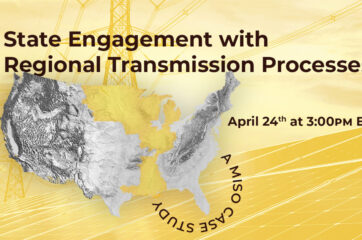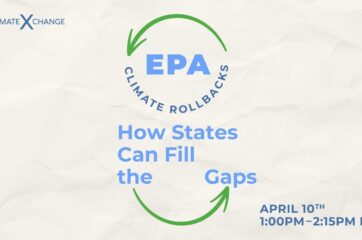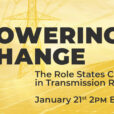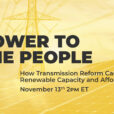After years of ambitious campaigns to set clean energy targets and pass enabling policies across the country, the focus is now expanding to how and when these much-needed investments will take place. Transforming the power grid can be slow and complex, but it’s crucial that states are able to overcome transmission barriers on a shorter timescale.
We invited a panel of experts to discuss how states can overcome long standing barriers to the grid transition to ensure that their investments are as effective and timely as possible. On this webinar, we featured
- Hannah Hess, Associate Director at Climate Impact Lab & Rhodium Group;
- Charles Harper, Power Sector Senior Policy Lead at Evergreen Action;
- Daniela Schulman, Clean Power Policy Consultant at Evergreen Action; and
- David Sarkisian, Principal Analyst, Energy Policy and Markets at the North Carolina Clean Energy Technology Center.
In this recap article, we’ll provide highlights from our expert panel’s presentations, including an overview of the current status of clean energy investments from the BIL and IRA, best practices for addressing state siting and permitting barriers, and opportunities for state grid modernization policy.
Hannah Hess, Rhodium Group & Climate Impact Lab
Hannah Hess is an Associate Director with Rhodium Group’s Energy & Climate practice, overseeing projects related to Rhodium’s work estimating the costs of climate change as part of the Climate Impact Lab. Hannah specializes in communicating the relationship between climate and society. Before joining Rhodium, she spent five years working as a journalist in Washington, DC, where she wrote on a wide range of topics that included federal climate and energy policy, regulatory reform, congressional politics, presidential campaigns, ethics, and lobbying.
The Inflation Reduction Act (IRA) and Bipartisan Infrastructure Law (BIL) set the stage for U.S. clean energy deployment and the scale-up of climate tech. One of the IRA’s stated objectives is to reduce greenhouse gas emissions by 40 percent by 2030, compared to 2005 levels. Recent independent reports from Energy Innovation, the REPEAT Project, and Rhodium Group all conclude that implementing the IRA puts the U.S. on track to reduce emissions by 37 to 42 percent by 2030. In order to track the clean energy investments that would actually achieve that impact, Rhodium Group and the MIT Center for Energy and Environmental Policy Research (CEEPR) launched the Clean Investment Monitor (CIM), which compiles clean investments from 2018 onward and includes data from manufacturing facilities, heat pump sales, distributed energy and storage installations, and more.
Transportation Sector Investments
Transportation is the highest emitting sector in the U.S., but fortunately investments in clean transportation are generally matching projections from the IRA. Zero emission vehicle (ZEV) sales, including battery electric vehicles, plug-in hybrids, and fuel cell vehicles, are moving faster than forecasted, making up 9.2 percent of total light-duty vehicles sold in 2023. In 2020, prior to the passage of the IRA, ZEV sales for 2023 were projected to be around 580,000 vehicles, which is just over a third of actual 2023 sales. The country experienced a 52 percent growth in ZEV sales in 2023, however it’s expected to decrease slightly for 2024 as ZEVs move from the fringes of the market into the mainstream, making high growth rates harder to sustain. This would still be aligned with ZEV sale projections needed to achieve U.S. climate goals.
Power Sector Investments
The power sector is proving much harder to decarbonize, even with impressive growth last year. 2023 added a record 32.3 gigawatts (GW) of electric capacity to the grid, supported by the IRA’s tax credits which make most renewable sources of electricity cheaper to build than coal and natural gas. Solar and storage additions are encouraging, with 18.4 and 6.4 GW added, respectively, whereas wind installations lag behind post-IRA projections at 6.3 GW, primarily due to a drop in new onshore wind projects.
Unfortunately, this record expansion of 32 GW is not enough to meet U.S. climate goals — IRA implementation modeling projected that 46 to 79 GW of new zero-carbon power would come online in 2023. To remain on course with projections, the U.S. needs to add between 60 and 127 GW of capacity this year. According to the CIM, 60 GW of clean electricity capacity is under development with a 2024 start date, but projects starting at this time of year tend to slip back on their timelines and it’s likely that the 2024 capacity additions will come in considerably low.
From 2025 to 2030, clean energy installation should increase even further to between 70 to 126 GW per year. This means installing more than double the amount of clean energy added in 2023 each year moving forward.
What’s Next?
While ZEV deployment is on track with IRA emissions reduction projections, the power sector is not. Investment in utility-scale clean electricity generation and storage capacity is at risk of falling behind, even as renewables are cost-competitive with coal and natural gas. Achieving our target emissions reductions is contingent on building clean infrastructure at an unprecedented pace and scale, which requires addressing non-cost barriers related to siting and permitting, interconnection queues, and supply chain challenges.
Read more about the current state of transportation and electricity investments in the February 2024 report from the Clean Investment Monitor, Clean Investment in 2023: Assessing Progress in Electricity and Transport.
Charles Harper and Daniela Schulman, Evergreen Action
Charles Harper is the power sector senior policy lead at Evergreen Action and has dedicated his career to achieving ambitious climate action at the federal and state levels. Previously, he advocated for wind and solar energy at the American Clean Power Association, advised states on the energy transition as a program officer at the National Association of Regulatory Utility Commissioners, and researched environmental regulation at the Yale Center for Environmental Law & Policy.
Daniela Schulman is a power sector consultant for Evergreen Action, where she advances state and federal policies to tackle the climate crisis and build a just and thriving clean energy economy. Previously, Daniela served as Lab Manager under Dr. Leah Stokes and Dr. Matto Mildenberger at the University of California, Santa Barbara. Daniela has worked on coastal climate resilience at Urban Ocean Lab, transatlantic climate diplomacy at E3G, and local climate campaigns at Washington Conservation Action.
With the IRA and BIL, our climate goals are within reach in terms of cost, but we have a huge bottleneck when it comes to the transmission grid itself. Estimates show that we need to double the pace of transmission growth and quadruple the pace of renewable energy growth by the end of the decade.
The Biden administration and FERC must use existing authority to address multiple sources of delay in clean energy permitting and transmission buildout. It’s important that they act as soon as possible, without waiting on Congress or simply shortening federal environmental review (which can also pave the way for fossil fuel projects). Additionally, we need state laws that speed up siting and permitting processes for transmission and clean energy while strengthening community engagement and benefits.
Federal Executive Action on Transmission and Permitting
Teeing Up Transmission at FERC and DOE
The Biden administration is on the cutting edge of exploring how clean energy can be built and approved faster in a way that maintains community input, and these federal actions can serve as inspiration for states looking to use executive action for their own transmission reform.
In the coming weeks, the Federal Energy Regulatory Commission (FERC) is set to finalize a major rule around transmission that will require utilities, regional transmission organizations (RTOs), and other grid planners to proactively plan the transmission grid for the future and consider all benefits that transmission can bring, including reducing constraints on the grid, increasing reliability, and bringing low-cost power online. This serves as a great opportunity for states, RTOs, and grid operators to ensure this is implemented well to set us up for the massive grid transition we need.
The Department of Energy (DOE) is also pursuing a rule that will make DOE the lead coordinating agency to expedite siting and permitting. States can also benefit from this strategy, as lack of interagency coordination is a key barrier to an accelerated timeline.
Permitting Developments at CEQ and Federal Agencies
The White House Council on Environmental Quality is finalizing a Phase II rulemaking regarding the National Environmental Policy Act (NEPA), in an effort to strengthen environmental permitting statutes and review processes for clean energy and transmission, alongside improving the environmental justice and community input processes. States can look to this rulemaking for ways to strengthen their own state-level NEPA equivalent.
Federal permitting agencies are also making big changes. Expanded Programmatic Environmental Impact Statements (PEISs), aimed at conducting a larger, landscape-level analysis of a program’s environmental impacts, save time and reduce redundancies down the line as an individual project’s environmental assessment can refer to their higher-level PEIS. States can use this as an example for their own permitting; for example, California’s Desert Removal Energy Conservation Plan, developed in conjunction with federal agencies, significantly reduces permitting time for solar projects.
State Legislative Opportunities on Siting and Permitting
Many of the previously mentioned federal actions have their equivalents at the state level, and without strong state coordination, local siting and permitting can compound administrative burdens, spur local opposition, and increase the likelihood of project delays or cancellations. To avoid these challenges, states can pass laws that streamline clean energy siting and permitting and ensure clear and visible benefits flow to host communities.
As DOE is set to do at the federal level, states can designate one lead agency to better coordinate review, such as a public utility commission, environmental department, or built-for-purpose siting board. States are also encouraged to set reasonable and transparent timelines that go hand in hand with increased coordination, staff capacity, and upfront planning. Laws addressing this issue would need to allow ample time for community input and robust Tribal consultation.
States can also use legislation to help guard against local opposition, through shifting siting authority from the local to state level, or exercising backstop authority when localities unjustifiably deny permits or fail to approve them on time. The establishment of opt-in programs stops short of replacing local approval, but still gives clean energy and transmission developers the option of an expedited review process. States can also minimize and address adverse impacts, or even provide net conservation benefits. This can be done by requiring upfront analysis of clean energy infrastructure — such as PEISs — mapping out siting locations, and setting statewide standards like setback rules, noise limits, height restrictions, and more, influenced by input from affected and disadvantaged communities.
States are strongly encouraged to require community benefits agreements (CBAs), which are enforceable contracts that commit developers to providing specific local benefits like local hiring guarantees, job training programs, energy bill discounts, and local infrastructure investments. CBAs should be developed alongside a diverse set of stakeholders to address specific local needs. States should also require upfront consultation with Tribes, both with and without federal recognition, and respect Tribal sovereignty and resources. States must abide by treaty rights, interacting with Tribes at the same level as they would any other sovereign nation.
States should require cumulative impact analyses, which necessitate that permitting agencies consider a proposed project in the community context, thinking about existing infrastructure, community composition, local environment, and more, not only for clean energy projects but also for polluting fossil fuel projects. A great state example of this type of legislation is New Jersey’s environmental justice law: if a proposed project is found to cause a disproportionate burden, its permit must be denied, ensuring that a cumulative impact analysis is not just a box checking exercise. States should require early, meaningful, and transparent engagement with affected communities, prioritizing overburdened and underserved communities from the earliest stages of planning. States are also encouraged to establish dedicated funding streams for intervenor compensation to ensure that engagement is accessible for all.
State Case Studies on Siting and Permitting
Various states are leading the way on innovative approaches to siting and permitting reform. Michigan’s HB 5120 and 5121 reformed siting for wind, solar, storage, and associated transmission, and similarly to California’s AB 205, they established a lead agency which offers an opt-in process or requires project decisions within one year, alongside strong requirements for CBAs and community engagement.
Illinois’s HB 4412 takes a different approach, where the state chose to retain county siting authority for wind and solar, but set statewide rules that counties cannot further restrict. Washington’s HB 1812 and HB 1216 designate the Department of Ecology as the lead agency for siting and permitting and allocate $30 million in additional funding to increase capacity and administer grants to Tribal communities to support their engagement. The Department of Ecology also has to conduct three PEISs for clean technologies that would identify impacts and mitigation measures, and make it easier to conduct project-level review.
Currently, exciting permitting legislation in New York is under consideration, following previous laws (A9508-B, S8830) that established a first of its kind Office of Renewable Energy Siting (ORES) as the lead agency for renewables permitting. The Renewable Action through Project Interconnection and Deployment (RAPID) Act would expand ORES to also permit transmission projects, requiring proof of consultation with local governments, establishing intervenor funds for community members, and creating statewide standards that must have net benefits for endangered species and habitats. This provides an example of legislation that hits the balance of safeguarding the environment, preserving local input, and cutting the timeline for transmission projects by more than half.
Read more about expediting permitting and equitable grid deployment without Congress in the December 2023 report by Evergreen Action, Warp Speed Clean Energy.
David Sarkisian, North Carolina Clean Energy Technology Center
David Sarkisian is a Principal Policy Analyst at the NC Clean Energy Technology Center. David contributes to the 50 States of Solar, 50 States of Grid Modernization, and 50 States of Electric Vehicles reports and the team’s other DSIRE Insight subscription services. David served as the Principal Investigator for the Community Solar for the Southeast Project and led the Center’s work on the Solar-Plus for Electric Cooperatives project. He has also worked as a SolSmart advisor.
To accelerate the clean energy transition, we must focus on making the electricity system more resilient, responsive, and interactive through robust grid modernization policy. This includes issues related to smart grid and advanced metering infrastructure, utility business model and rate reform, regulatory reform, energy storage, microgrids, and demand response. However, barriers related to access to wholesale markets, incorporation of variable resources, and the consideration of distributed energy resources (DERs) in planning processes are holding us back from deploying the advanced grid technology we need.
Access to Wholesale Markets
Clean energy projects can have difficulty connecting to wholesale markets. Market rules are not traditionally equipped to handle the characteristics of clean energy resources, like the variability of solar and wind energy, and the services that energy storage can provide. In addition, due to the volume of new resources coming on the market, there are major interconnection backlogs.
Recent FERC rule changes have helped address these issues, such as Order 841, which ensures access to wholesale markets for electric storage resources, and Order 2023, which reformed interconnection processes by: (1) allowing project review using a cluster study approach, (2) adopting a first ready, first serve system rather than first come, first serve for projects connecting, and (3) allowing resources like solar and storage to co-locate behind a single point of interconnection. FERC Order 2222 aimed to ensure access to wholesale markets for DERs by allowing smaller DERs to aggregate to a resource scale. Outside of FERC, wholesale market expansion into new areas can increase access for clean energy resources, as seen with the California Independent System Operator (CAISO), Southwest Power Pools (SPP), and the Southeast Energy Exchange Market (SEEM).
Incorporation of Variable Resources
Grid modernization policies can also address barriers related to the incorporation of variable resources. Advanced metering infrastructure (AMI), can facilitate more accurate compensation of DERs, and direct load management programs, wherein utilities can directly manage demand response resources like HVAC and compensate customers upfront. Some utilities have installed distributed energy resource management systems (DERMS), which are utility-level technologies that enable them to incorporate the attributes of DERs at the distribution system level. Microgrids are another option to provide resilient services.
Energy storage can also facilitate variable resources, and 10 states currently have energy storage targets, with Maryland and Michigan being the most recent to adopt. Incentives for distributed level storage are also a state policy option, with states like Illinois providing rebates for distributed storage and attributed generation and California utilizing a self generation incentive program.
Time-of-use rates are another way to overcome these barriers, by utilizing a rate structure that can reward DER for providing energy services at peak times. Some states have been moving toward mandatory residential time-of-use rates, like Missouri, although there has been some pushback. Rates may also include critical peak pricing, which incentivizes generation at particular peak times, or real-time pricing based on wholesale market prices. DER compensation, like through net metering, has been controversial, but is moving toward more sophisticated, accurate rate structures, as seen in Illinois and Hawai’i.
Consideration of DERs in Planning Processes
An important way to tackle barriers related to planning involves integrating rules into utility planning processes that require a more thorough consideration of clean energy resources and DERs. Utilities can also be given incentives in performance-based ratemaking for incorporation of DERs.
Energy storage is playing a large role in many utility resource plans, with states like Delaware considering legislation to require integrated resource plans (IRPs), and further, to require IRPs that align with state clean energy goals, as in Michigan. Distribution system planning processes can also encourage utilities to consider non-traditional alternatives to standard grid investments, such as non-wires alternatives and energy storage on the distribution system. In some states, there has been pushback on utility distribution system plans, such as Illinois, where grid plans were rejected for being too costly and not sufficiently addressing the state’s climate goals.
Utility business model reform, such as performance-based ratemaking, can alter traditional incentives for standard grid and resource investments, as has been the case in North Carolina and Connecticut, among other states. By including DER incorporation in performance metrics, you can directly induce more interconnection of DERs, and similarly, incentives can be created for energy efficiency, demand response, and incorporation of energy storage.
Q&A
Q: Are there specific steps or approaches to ensure CBAs aren’t used, or perceived, as a tool to influence communities to accept harm or impacts that they would not otherwise agree to?
Daniela Schulman: I think that’s a great question, because if poorly designed, CBAs can really let communities down, and they can be little more than a payoff that looks, from the outside, like developers are just using their resources to site where they want to. I think, ideally, CBAs should be the end result of a really robust and meaningful community oriented process. What it comes down to is, what does the structure of the agreement look like? And what steps did you take to get there? I’m in California, and UC Berkeley’s law school actually just released a great report on CBAs and offshore wind, which is a hot topic in our state. That’s a great external resource where you can learn about all of the things around what makes a good, strong CBA.
Q: What advice do you have for overcoming environmental opposition to transmission lines?
Charles Harper: That one is really tough. The challenge with transmission, as opposed to clean energy projects, is that oftentimes communities might not see the direct benefit of the line itself, especially for long distance or interstate lines. Say a transmission line is connecting a wind farm in Oklahoma to power in Arizona. It passes through New Mexico, but New Mexico doesn’t see a benefit directly from the electricity, and that can make siting those types of projects difficult.
So there have been a few approaches that developers and states have been looking at. A few include some substations along the way that ensure that some of the power is being shared with communities it’s passing through, or CBAs like Dani just discussed, that ensure that there’s some tax benefit or job creation or revenue for communities that are the home base for some of these long distance transmission projects, but it is really difficult. There are some solutions, obviously, with undergrounding transmission lines or looking at grid enhancing technologies that reduce the need for new transmission, but we are going to need a lot of newly built transmission to achieve all of our climate goals. Siting will continually be an issue. One thing I would say, as an environmental person who likes transmission, is that transmission lines, unlike fossil fuel projects, aren’t killing folks and causing cancer and asthma in communities. It’s usually a visual impact, which can be real, but is not necessarily the same category of impacts that some of these polluting facilities will have. But it’s a tough one for sure, and lots of folks are grappling with it every day.
Daniela Schulman: I would just jump in to add that opposition is not a monolith. So I think trying to tackle it head on head on takes a really targeted approach — are community members upset about a real impact? Or are they being absolutely buried in misinformation that needs to be countered by experts or state agencies? Often with these projects, the people that community members interact with the most are developers. I think there’s room for both state policymakers and advocates to play a bigger role here.
There’s actually some great organizing in the works to try to create a more coordinated effort to say, yes, please, greenlight clean energy infrastructure in my community; I think the people you hear from the most are the folks who are going to die on the hill opposing it. So we want more people to come forward saying they want a renewable energy transition that’s going to provide family sustaining jobs in their community. Then states, too, can be there separately, alongside developers, so that you’re not just hearing from the big corporate world about what’s going to happen and the changes that are going to come. Of course, caveat, you can’t get rid of all opposition, right? You can do everything you can, you can take all the right steps and at the end of the day, you can’t convince everybody.
Conclusion
To meet the urgency of the climate crisis on the timescale we have, we must look to scale innovations in electricity and grid policy that are already being piloted by states across the country. These include designating a lead permitting agency, setting transparent and reasonable timelines, and requiring robust community and Tribal engagement. State policy should also focus on enabling grid modernization through reforming utility and regulatory rates and business models, and incentivizing smart grid technologies and energy storage deployment. With wide scale adoption of these innovative policies, states can overcome barriers to a clean energy economy and achieve emissions reductions in the electricity sector.
* The views and opinions expressed by our guest speakers during the webinar and summarized in this article are their own and do not necessarily reflect the views or positions of Climate XChange.








